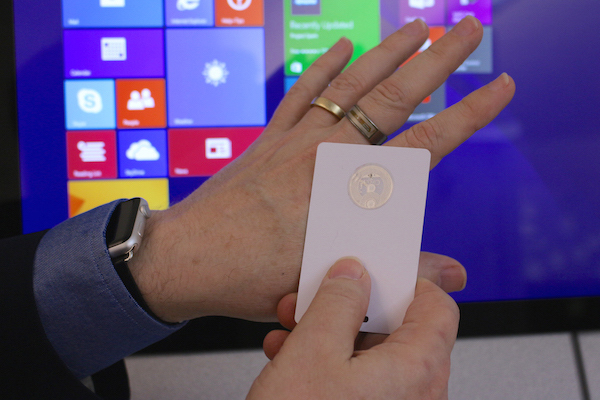$20 million grant powers game-changing Internet access effort

The Global Public Inclusive Infrastructure will allow people to use a ring or a card with a special key on it to cue digital devices to instantly access the users’ needs and preferences — such as simplified interfaces, large type, audio aids, captions, high-contrast screens and other features.
Photo: Renee Meiller
A global effort to create a new computer ecosystem that is easily accessible to people with disabilities, senior citizens and others with special needs is set to become reality through a $20 million federal grant to the University of Wisconsin–Madison.
The five-year project will develop and deploy the first operational version of the Global Public Inclusive Infrastructure (GPII) in a large-scale pilot test. This new infrastructure will be accessed via the Internet, allowing people who have difficulty using today’s technology to select and configure the assistive features and settings needed to enable their use of the information and communication systems encountered in school, work and the community.

Gregg Vanderheiden
“This project will move research to reality,” says Gregg Vanderheiden, an engineering professor and director of UW–Madison’s Trace Center. “The project will help make it so that whenever a person encounters something with a digital interface — a computer, Web page, TV, themostat — the interface on the device or Web page instantly and automatically changes into a form that the person can understand and use.”
Vanderheiden, an industrial and systems engineering professor who first conceived of the GPII seven years ago, says users could carry a card or a ring or USB flash drive with a special key on it. The key cues the devices to instantly access the users’ needs and preferences — such as simplified interfaces, large type, audio aids, captions, high-contrast screens and other features.
For those who are averse to technology or confused by it, the system could provide simplified interfaces that make computers and other devices vastly more understandable.
The technology, Vanderheiden says, has the potential to be transformative.
“Society is creating a world where you cannot get an education or job, travel, or increasingly communicate socially, unless you can use technology and digital interfaces,” Vanderheiden says. “Yet there are many people who, because of disability, literacy, digital literacy or aging, can’t use the technologies they encounter. As a society we are designing the world out from under these people.”
“There are many people who, because of disability, literacy, digital literacy or aging, can’t use the technologies they encounter. As a society we are designing the world out from under these people.”
Gregg Vanderheiden
For the last four years, an international consortium has been working on prototypes in Europe, with Vanderheiden serving as technical director. The latest grant, the first from the U.S. Department of Education’s Disability Innovation Fund, will allow Vanderheiden and his international team to build out the GPII’s automatic personalization features and put them into use in a pilot project involving up to 15,000 users.
In announcing the grant, U.S. Education Secretary Arne Duncan recognized the technology’s promise.
“When students have access to powerful mobile devices and digital resources that are coninually updated, they realize that learning doesn’t stop with the last school bell of the day,” Duncan said. “As we build tomorrow’s workforce, this project allows everyone to participate — no matter their disability.”
Vanderheiden says the first two years of the grant will be devoted to creating a commercial grade version of the cloud-based system, working with IBM and Microsoft as industry partners. During the last three years, the technology will be deployed to an estimated 15,000 users at the Onondaga Community College and several high schools in Syracuse, New York, and at American Job Centers across the country.
During the pilot testing, researchers will work with users — those with and without disabilities — to identify the most required and desired features, to optimize the interfaces, and to determine the impact of easier access to communications and information technology.
For those who are averse to technology or confused by it, the system could provide simplified interfaces that make computers and other devices vastly more understandable.
“Our goal is to make it so compelling that people both with and without disabilities will use it, so that those who need it don’t stand out when they use it,” Vanderheiden says. “If you’re a teenager with a learning disability, the last thing you want is something that highlights that you have a learning disability. But if everyone around them is using it as well, then they are just another user with different preferences.”
The results of the large pilot tests will be critical to decision-making on the part of industry and government regarding wider implementation of the technology.
Vanderheiden says IBM will be evaluating the system for scalability, reliability and security of the cloud-based service. Microsoft will help ensure that the system integrates well with their Windows operating system — one of the primary initial target systems for the GPII.
Ultimately, Vanderheiden says, the plan is to make a spectrum of digital devices — from thermostats, to public ticket kiosks, to future home appliances — part of the effort.
In addition to IBM and Microsoft, organizations collaborating on the project include the Raising the Floor coalition, the Burton Blatt Institute at Syracuse University, OCAD University, the Center for Civic Design, Inclusive Technologies and others.




